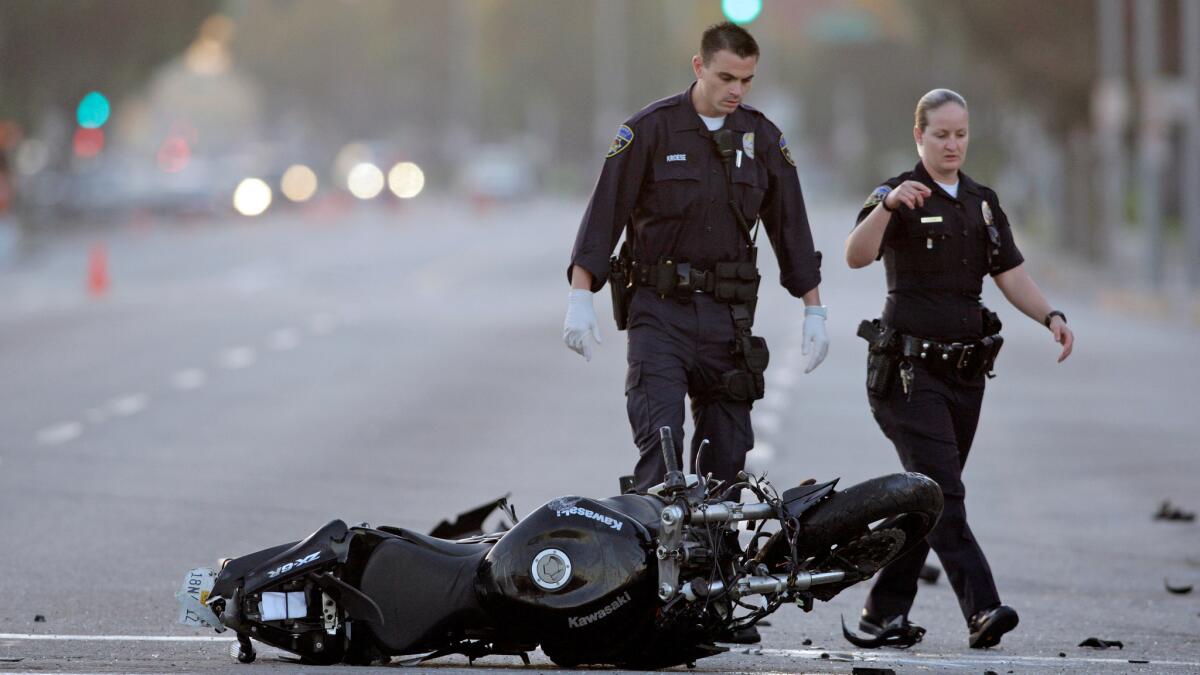Motorcycle deaths jump nationwide but fall in California. Why?

- Share via
Motorcycle fatalities on U.S. roads rose 10% in 2015, according to estimates from the Governors Highway Safety Assn.
Those estimates show that more than 5,000 motorcycle riders died in 2015, up from 4,548 in 2014. That makes 2015 the third year in history when the body count was above 5,000.
In California, motorcycle deaths fell by 7%, the report said. But because of the large motorcycle population here, the state’s total number of motorcycle deaths were second only to Florida’s.
Why the rise? The GHSA report theorized many causes.
Among them: A short, relatively warm winter ended early, extending the number of riding days; lower average fuel prices contributed to more miles ridden and driven overall; and a generally stronger economy appears to have put more motorcycles on the road.
As it does each year when it issues its report, the GHSA emphasized that legislation requiring helmet use was “critical to reducing motorcycle deaths and injuries” and posed the best immediate remedy to rising motorcycle deaths.
Currently only 19 states require helmets for all motorcycle riders. An additional 28 states require only younger riders to wear a helmet. Three (Illinois, Iowa, New Hampshire) have no helmet requirements at all, despite demonstrable evidence that Department of Transportation-approved helmets save lives.
“The most important injury protection mechanism for motorcyclists is to wear a DOT-compliant helmet,” the study said. “Helmets reduce head and brain injuries and decrease the risk of dying in a crash by 37%.”
In 2013, according to the National Highway Transportation Safety Administration, 715 deaths would have been prevented had the riders been wearing helmets when they crashed.
The report concluded that “there is no evidence that motorcyclists can be persuaded to wear helmets through educational techniques,” but that laws mandating helmet use for all riders can bring helmet use to almost 100%.
It also emphasized that motorcycling, in general, is a dangerous activity.
“Motorcycling is a risky form of transportation, especially when combined with factors such as lack of helmet use, speeding, alcohol and invalid licensure,” the study said.
On the basis of miles driven, the fatality rate for bikers was 26 times higher than that of passenger vehicle occupants in 2013, the last year for which comparable numbers have been compiled.
In California, for example, motorcycle deaths represented 17% of all road fatalities, though motorcyclists nationwide represent only 3% of registered vehicle owners and are responsible for only 1% of vehicle miles traveled.
See the most-read stories this hour >>
The great majority of those killed were male — more than 90% of the 2014 fatalities, the study said.
The 20-29 age group had the highest share of deaths, representing almost 25% of the total, though the 50-59 set was not far behind.
A bright note? The study determined that the increasing inclusion of anti-lock braking systems as standard equipment on motorcycles is likely to help reduce deaths. (So-called ABS systems are mandatory on all motorcycles in the European Union, but are still just an available option on many motorcycles sold in the U.S.)
In a 2013 study by the Insurance Institute for Highway Safety, the GHSA said, the rate of fatal crashes was 31% lower for motorcycles equipped with ABS compared with those without it.
ALSO
Collector Robb Talbott takes top honors at Quail Motorcycle Gathering
Elon Musk responds to exposé on foreign laborers at Tesla plant
Tesla to sell $2 billion in stock to speed up the production of its Model 3 sedan
Follow me on Twitter @misterfleming




